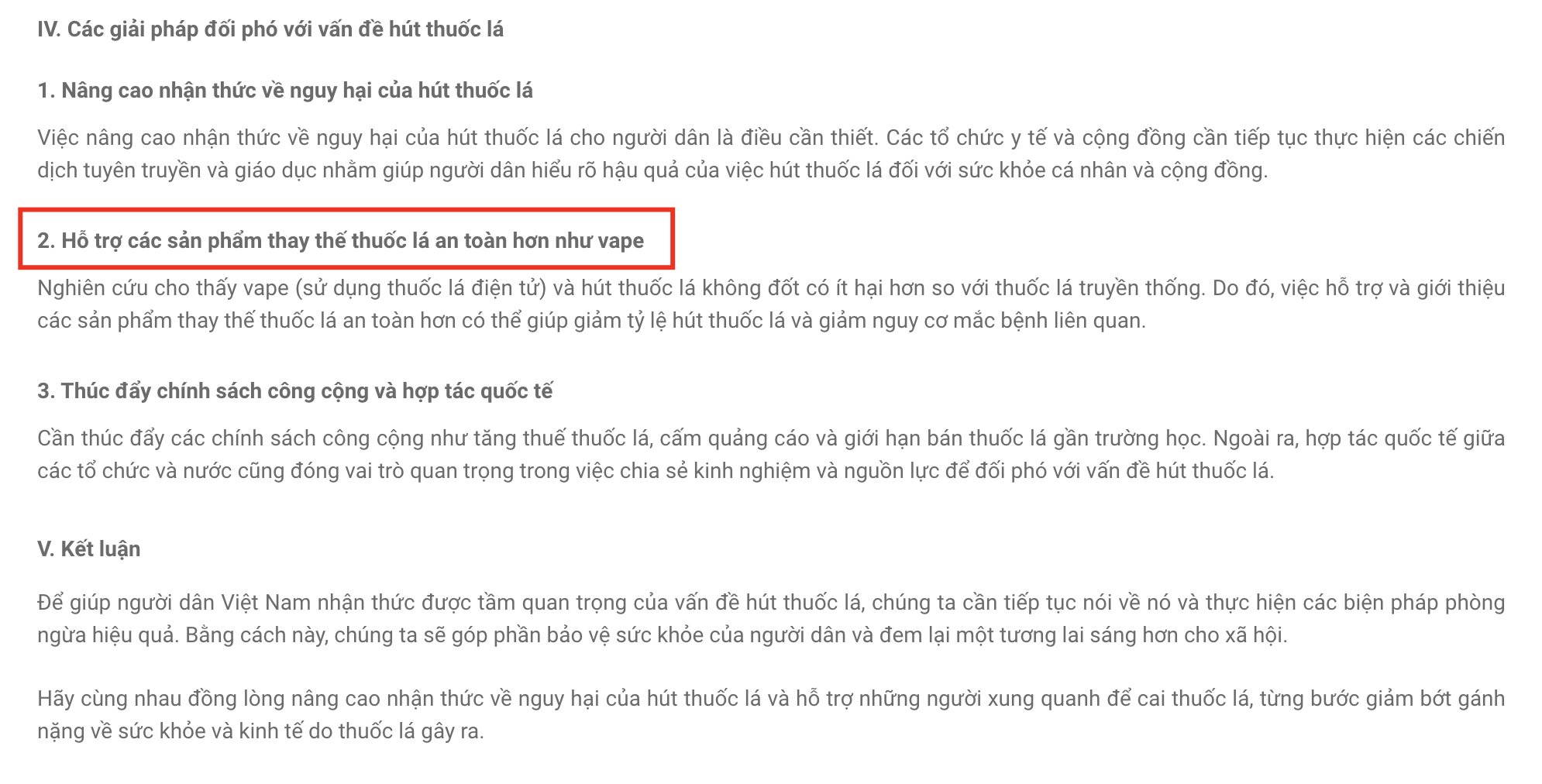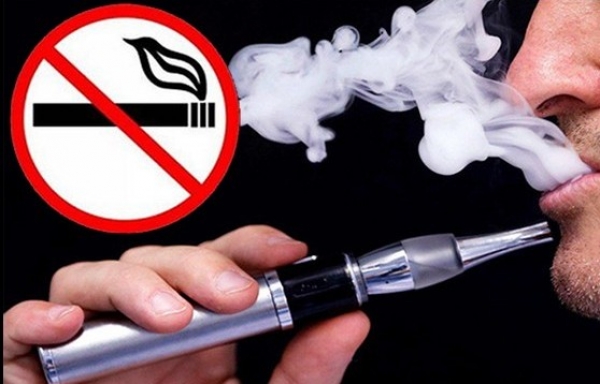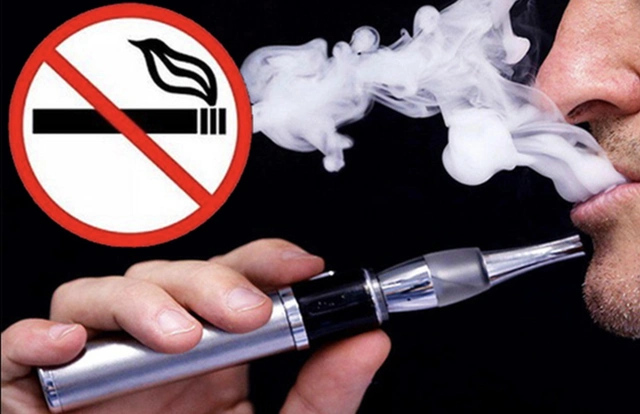Misconception that e-cigarettes help quit smoking
It is not difficult to come across advertisements on e-commerce platforms, social media channels, and websites selling electronic cigarette products with the assertion that " research shows that vapes (electronic cigarettes) are less harmful than traditional cigarettes. Supporting and introducing alternative products to cigarettes can help reduce smoking rates and reduce the risk of related diseases". Although the origin and credibility of the research are unclear, many people have quickly used electronic cigarettes with the belief that this is a safe alternative with little impact on health.

Misinformation about e-cigarettes being safer than traditional cigarettes is spreading on online e-cigarette sales sites. Photo: Thevapeclub.vn
In its 2019 Global Tobacco Epidemic report, the World Health Organization (WHO) stated that there is currently no scientific evidence that e-cigarettes can help people quit smoking traditional cigarettes. In fact, according to a study on smoking cessation methods among American adults by the US Centers for Disease Control and Prevention (CDC), most people who use e-cigarettes to quit smoking are not able to quit, instead they continue to use both e-cigarettes and traditional cigarettes.

The use of e-cigarettes among young people is promoted as a lifestyle. Photo: Fanpage The Vape Club
More alarmingly, e-cigarettes are increasing the risk of young people using conventional cigarettes. Specifically, a study published in the Journal of the American Medical Association (JAMA) in 2017 showed that adolescents and young adults who use e-cigarettes are 3.5 times more likely to start smoking traditional cigarettes than those who have never used e-cigarettes.
Gateway to social evils
E-cigarettes, including some new types of heated tobacco products, use many flavors and chemicals that are not from tobacco leaves. The ingredients are mixed with many different ingredients, so they can be exploited for drug use through mixing. Users can arbitrarily increase the nicotine ratio too much or add drugs and other addictive substances to use without being detected. A survey conducted on 20,675 American teenagers (grades 6-12) showed that 8.9% of students had used drugs from cannabis mixed with e-cigarette solution.
Several surveys in the community of e-cigarette users clearly show the relationship between e-cigarette use and other social evils such as drugs, shisha smoking and other addictive substances. Mixing drugs into e-liquids (Cannabis and Marijuana) has been recorded at the Poison Control Center of Bach Mai Hospital and the Drug Identification Center of the Institute of Criminal Science - Ministry of Public Security. These consequences have a negative impact on the health, environment, lifestyle and behavior of young people.
In Vietnam, although there are no specific statistics on the rate of use of marijuana combined with e-cigarettes among young people and students, emergency cases due to poisoning from synthetic drugs mixed in e-cigarettes are on the rise. The Poison Control Center of Bach Mai Hospital is a place that regularly receives emergency cases of patients in deep coma, psychosis, lung damage, convulsions, difficulty controlling behavior, etc.

The situation of drugs disguised as electronic cigarettes is increasingly complicated. Photo: Bach Mai Hospital
Last July, the hospital admitted two critically ill patients due to using e-cigarettes mixed with 3-4 synthetic drugs including MDMB-4 en-Pinaca, MDMB-Chminaca, ADB-4 en-Pinaca and ADB-Binaca. Normally, just one substance can cause brain damage and endanger the user's life. Therefore, the situation of mixing many drugs at the same time in e-cigarette solution is posing a significant challenge related to medical and social issues, threatening the health and future of adolescents.
Restricting the use of traditional cigarettes or e-cigarettes is not easy, even in developed countries. To date, 42 countries in the world have issued regulations banning e-cigarettes, including 5 Southeast Asian countries: Brunei, Thailand, Laos, Cambodia and Singapore. Most low- and middle-income countries have chosen to ban new tobacco products.
In order to prevent negative impacts on the socio-economy and environment, the Ministry of Health has proposed that the Government ban all imports and circulation of electronic cigarettes. This is also the viewpoint that received consensus from the National Assembly's Committee on Culture and Education and experts, educators and scientists in the Seminar on the harmful effects of new cigarettes on adolescents held on October 12 in Hanoi. Experts emphasized that allowing more e-cigarettes to circulate on the market goes against the principles of reducing supply and reducing demand of the Framework Convention on Tobacco Control, the National Strategy on Tobacco Harm Prevention (PCTH) and the Law on Tobacco Harm Prevention. |
Source


![[Photo] Third meeting of the Organizing Subcommittee serving the 14th National Party Congress](https://vstatic.vietnam.vn/vietnam/resource/IMAGE/2025/4/2/3f342a185e714df58aad8c0fc08e4af2)



![[Photo] Relatives of victims of the earthquake in Myanmar were moved and grateful to the rescue team of the Vietnamese Ministry of National Defense.](https://vstatic.vietnam.vn/vietnam/resource/IMAGE/2025/4/2/aa6a37e9b59543dfb0ddc7f44162a7a7)





























































































Comment (0)